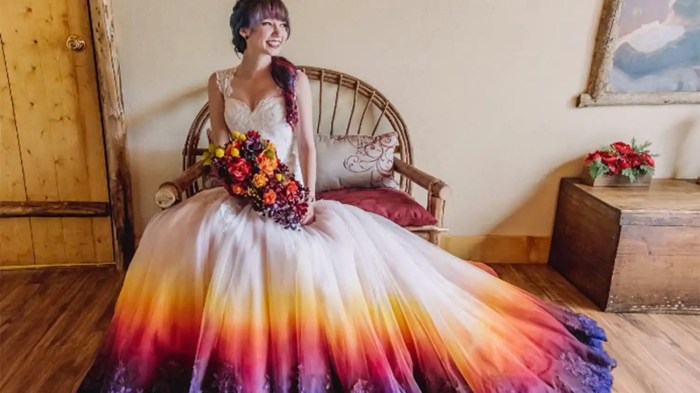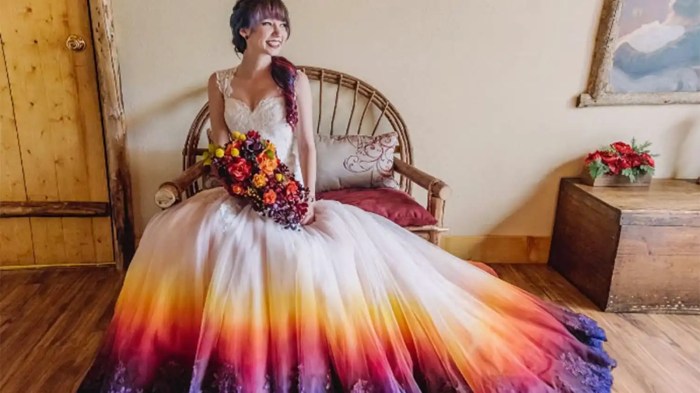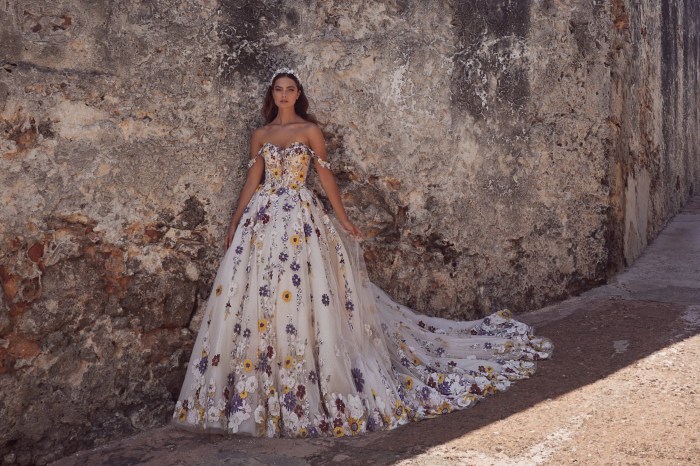Wedding Dresses of Color A Style Guide
Popularity and Trends in Colored Wedding Dresses
Wedding dresses of color – The traditional white wedding dress is evolving, with colored gowns gaining significant popularity. This shift reflects a broader trend towards personalization and self-expression in weddings. This section will explore current trends, compare the popularity of various colors, and analyze the factors driving this change.
Current Trends in Colored Wedding Dresses

Source: s-nbcnews.com
Current trends show a move away from stark, bright colors towards softer, more nuanced shades. Muted tones like blush pink, dusty rose, and champagne are extremely popular, offering a romantic and sophisticated alternative to traditional white. Deep jewel tones, such as emerald green, sapphire blue, and ruby red, are also making a statement, particularly for autumn and winter weddings.
Popularity of Different Colors Over the Past Five Years
While precise data on wedding dress color popularity requires extensive market research, anecdotal evidence and industry observations suggest a significant rise in non-white gowns. Blush pink has consistently ranked high, followed by ivory (which remains a popular choice). Navy blue and red have seen increasing popularity, especially among brides seeking a bolder statement.
Factors Influencing the Choice of Colored Wedding Dresses
Several factors influence a bride’s choice of colored wedding dress. Personal style and preference are paramount, with brides choosing colors that reflect their individual personalities and aesthetic sensibilities. The wedding theme, venue, and season also play significant roles. Additionally, cultural traditions and family preferences can influence the color selection.
| Color | Popularity Rank | Trend | Reason for Popularity |
|---|---|---|---|
| Blush Pink | 1 | Increasing | Romantic, versatile, complements various skin tones |
| Ivory | 2 | Stable | Classic, timeless, elegant |
| Navy Blue | 3 | Increasing | Sophisticated, flattering, suitable for various seasons |
| Red | 4 | Increasing | Bold, dramatic, perfect for a statement wedding |
Design Elements of Colored Wedding Dresses
The design elements of a colored wedding dress contribute significantly to its overall aesthetic appeal. This section will explore the various silhouettes, necklines, sleeve styles, embellishments, and fabrics commonly used.
Silhouettes of Colored Wedding Dresses
Colored wedding dresses are available in a wide range of silhouettes, catering to diverse body types and personal preferences. Popular choices include A-line gowns, which are flattering on most figures; mermaid or trumpet styles, which accentuate curves; and ball gowns, which offer a dramatic and romantic look. Sheath or column gowns provide a sleek and modern silhouette.
Necklines and Sleeve Styles
Necklines and sleeve styles significantly impact the overall look of a colored wedding dress. Popular neckline options include sweetheart, V-neck, halter, off-the-shoulder, and bateau necklines. Sleeve styles range from sleeveless and short sleeves to long sleeves, including bell sleeves, bishop sleeves, and puff sleeves.
Embellishments and Fabrics
Embellishments and fabrics add depth and texture to colored wedding dresses. Common embellishments include lace appliqués, beading, embroidery, sequins, and 3D floral details. Fabrics such as lace, satin, silk, tulle, and chiffon are frequently used, each contributing a unique texture and drape.
- Lace: Adds a delicate, romantic touch.
- Satin: Creates a sleek, luxurious look.
- Silk: Offers a luxurious, flowing drape.
- Tulle: Provides volume and texture.
- Chiffon: Creates a light, airy feel.
Color Psychology and Wedding Dress Selection
Color psychology plays a subtle yet significant role in wedding dress selection. Understanding the symbolic meanings associated with different colors and how they reflect the bride’s personality can help in making an informed choice. This section explores the impact of color choices on the overall wedding aesthetic.
Symbolic Meaning of Colors in Wedding Attire
Different colors carry various symbolic meanings. White traditionally represents purity and innocence, while blush pink symbolizes romance and femininity. Navy blue suggests sophistication and elegance, while red conveys passion and boldness. Understanding these associations can help brides choose a color that aligns with their desired mood and message.
Color Choice Reflecting Bride’s Personality, Wedding dresses of color
The color of a wedding dress often reflects the bride’s personality. A bride who prefers bold statements might choose a vibrant red or deep blue, while a bride seeking a more subtle look might opt for a pastel shade. The color choice should ultimately reflect the bride’s individual style and preferences.
Warm vs. Cool Colors in Wedding Dresses
Warm colors (reds, oranges, yellows) create a vibrant and energetic feel, often suitable for summer or autumn weddings. Cool colors (blues, greens, purples) evoke a sense of calm and sophistication, often preferred for spring or winter weddings. The choice depends on the desired atmosphere and the overall wedding theme.
Choosing a color that complements the bride’s skin tone and wedding theme is crucial. Brides with warmer skin tones often look best in warm-toned dresses, while those with cooler skin tones might prefer cool-toned dresses. The wedding venue and season should also influence the color selection. A vibrant red dress might be perfect for a summer garden wedding, while a deep navy gown might be more suitable for a winter ballroom wedding.
Styling Colored Wedding Dresses for Different Venues and Seasons: Wedding Dresses Of Color
Styling a colored wedding dress involves carefully considering the venue and season to create a cohesive and visually appealing look. This section will explore suitable dress colors and accessory suggestions for various settings and times of year.
Colored Wedding Dresses for Various Venues
The choice of wedding dress color can be influenced by the venue. A light, flowing gown in a pastel shade might be perfect for a beach wedding, while a richer, more structured gown in a jewel tone might be more appropriate for a ballroom wedding. A garden wedding might lend itself to softer shades or floral prints.
Wedding dresses of color offer a vibrant alternative to traditional white, allowing brides to express their individuality. For a whimsical and fun approach, consider the playful charm of tutu dresses for weddings , a unique option that perfectly complements a bold color scheme. Ultimately, the choice of dress, whether a colorful gown or a tutu, should reflect the bride’s personal style and the overall wedding aesthetic.
Styling for Different Seasons
Seasonal considerations are important when choosing a colored wedding dress. Lighter shades and fabrics are ideal for spring and summer weddings, while richer, darker colors and heavier fabrics are more suitable for autumn and winter weddings. The accessories can also reflect the season.
Accessories for Different Colored Wedding Dresses
Accessories play a crucial role in complementing a colored wedding dress. Jewelry, shoes, and veils should be chosen to enhance the overall look without clashing with the dress color. For example, a blush pink dress might be paired with rose gold jewelry and ivory shoes, while a navy blue dress might be complemented by silver jewelry and nude heels.
| Season | Venue | Dress Color Suggestion | Accessory Suggestions |
|---|---|---|---|
| Spring | Garden | Pastel pink or light blue | Floral crown, delicate jewelry, pastel-colored shoes |
| Summer | Beach | Ivory or champagne | Simple jewelry, sandals, a flowing veil |
| Autumn | Vineyard | Burgundy or deep green | Statement earrings, brown or burgundy shoes, a velvet shawl |
| Winter | Ballroom | Navy blue or emerald green | Elegant jewelry, heels, a fur stole |
Ethical and Sustainable Considerations
Ethical and sustainable practices are increasingly important in the wedding industry. This section will explore the ethical sourcing of fabrics, the environmental impact of different choices, and the benefits of choosing sustainable alternatives.
Ethical Sourcing of Fabrics
Choosing ethically sourced fabrics ensures that the production process is fair and does not exploit workers. Look for brands that use organic cotton, recycled materials, or sustainably harvested silk. Transparency in supply chains is key to ensuring ethical practices.
Environmental Impact of Fabric Choices
Different fabrics have varying environmental impacts. Synthetic fabrics like polyester often require significant energy to produce and contribute to pollution. Natural fabrics like organic cotton and linen have a smaller environmental footprint, but their production still has an impact. Choosing sustainable fabrics reduces the overall environmental cost.
Sustainable Wedding Dress Brands

Source: s-nbcnews.com
Several brands prioritize sustainability in their wedding dress production. These brands often use eco-friendly materials, employ ethical labor practices, and minimize waste. Researching and choosing such brands supports sustainable practices within the wedding industry.
Benefits of Secondhand or Rented Dresses
Choosing a secondhand or rented colored wedding dress is a highly sustainable option. It reduces textile waste, lowers the environmental impact, and can be more affordable. Many online platforms and boutiques offer a wide selection of pre-owned or rental wedding gowns.
Illustrative Examples of Colored Wedding Dresses

Source: kleinfeldbridal.com
This section provides detailed descriptions of colored wedding dresses, highlighting their unique features and how they might be styled for different occasions and body types.
Example 1: A Blush Pink A-Line Gown
Imagine a blush pink A-line gown crafted from delicate silk chiffon. The dress features a sweetheart neckline, delicate spaghetti straps, and a flowing skirt with subtle pleating. The overall impression is romantic, ethereal, and effortlessly elegant. It would be perfect for a spring or summer garden wedding.
Example 2: A Deep Emerald Green Mermaid Gown
Picture a deep emerald green mermaid gown made from luxurious satin. The dress has a high neckline, long sleeves, and intricate beading along the bodice. The mermaid silhouette accentuates the curves, creating a sophisticated and glamorous look. This gown would be ideal for a fall or winter ballroom wedding.
Example 3: A Navy Blue Ball Gown with Lace
Envision a navy blue ball gown made from rich satin with intricate lace appliqués adorning the bodice and skirt. The dress features a V-neckline and delicate cap sleeves. The full skirt adds a touch of drama and romance, making it suitable for a classic or vintage-themed wedding. The overall impression is regal and timeless.
Top FAQs
How do I choose a color that complements my skin tone?
Consider your undertones (warm, cool, or neutral). Warm undertones suit warm colors (reds, oranges, yellows), cool undertones suit cool colors (blues, greens, purples), and neutral undertones can wear a wider range of colors.
Can I wear a colored wedding dress to a religious ceremony?
It depends on the specific religion and denomination. Some may have stricter guidelines than others. It’s best to check with your religious leader or venue to confirm their policies.
How do I care for a colored wedding dress?
Always follow the care instructions provided by the designer or manufacturer. Dry cleaning is often recommended for delicate fabrics and vibrant colors to prevent fading or damage.
Are colored wedding dresses more expensive than white ones?
The price can vary greatly depending on the fabric, designer, and embellishments. There is no inherent price difference based solely on the color.



















